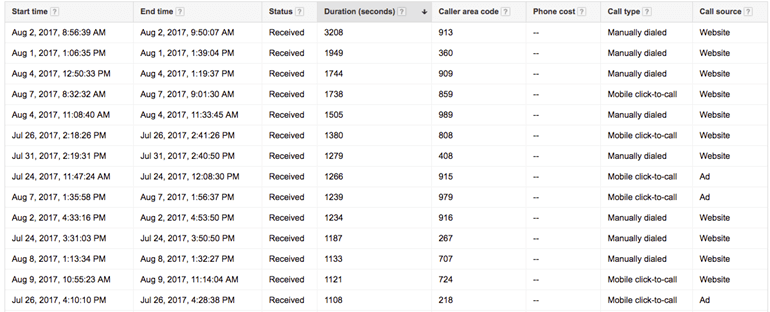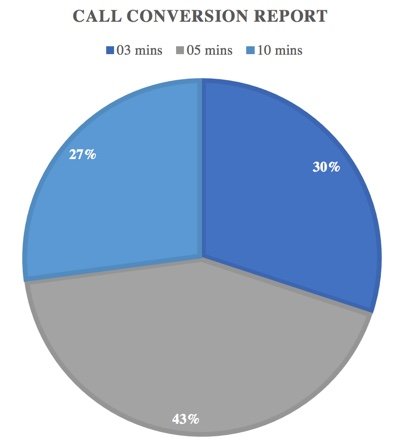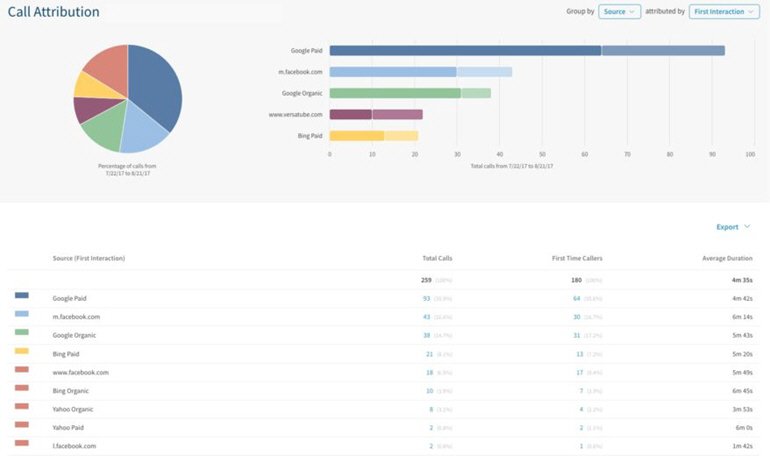Over the years, we have come across many clients who are not tracking phone calls. There are advertisers who get significant volume of phone calls. If your PPC accounts are missing this type of conversion, you could be making critical bidding errors. Whenever I am optimizing an account, I would rather have as much data as possible before deciding to shut a high traffic keyword off in your account. Let’s say you have a keyword driving 90% phone calls, but you turn it off because the CPA appears to be too high. Also, what if the CPA typically runs high, but one phone call generated a sale that was 20x’s higher than the spend on that term.
AdWords Dynamic Phone Call Tracking
AdWords gives you the ability to install Google Dynamic Phone Call Tracking and this is better than nothing. Installing this is free and does not incur any additional costs. The biggest challenge used to be getting it installed. However, now you can set an appointment with the Google Implementation Team and they will help you get it installed. This is also a free services offered by Google.
Tip: For the website to dynamically track phone calls, you will need to set up call extensions.
Once this is installed, you will begin to see which campaigns, adgroups, ads and even keywords are generating website phone calls. This is extremely helpful when it comes to measuring performance. Especially if you receive a high volume of phone calls from non-branded terms. Many times, phone calls coming in from Non-Brand terms are new customers. You are also able to set the minimum call duration before that phone call is counted as a conversion. In Dimensions, under Call Details, you will be able to see additional details about the phone calls.
Call Detail Report:
- Start time
- End time
- Call duration
- Area code
- Call type
- Call source

For example, these Non-brand keywords are driving more phone calls than form submissions or transactions. The conversion actions Calls from Website and Phone Call are the same thing. In this account, the client just switched over from Dynamic Call Tracking to a 14-day trial with Call Rail with call recording. So, we temporarily disabled the Dynamic Phone Call to prevent over tracking.
![]()
In another account, we noticed that one of their top spending keywords was only generating phone calls and no transactions. Upon further analysis, we noticed the prices of these products start around $2,000. The price may be one of the reasons customers are calling instead of placing an order online. Another reason could be that this company allows customers to finance and perhaps they are calling about this option. However, this is just speculation off the data we can see.
![]()
There are a few problems with only using Google Dynamic Call Tracking. The first one is that you can only see the duration of the call, but you have no idea what was discussed during the phone call. For one client, we were reporting between 60-70% of their conversions each month were phone calls. Of these call conversions, 27% of the calls were longer than 10 minutes, 43% were longer than 5 minutes. However, we really couldn’t say if these calls were leading to orders or not.

Call Tracking with Recording
In this account, the client just switched over from Dynamic Call Tracking to Call Rail with call recording. It has been extremely helpful to listen to their calls and realize how many customers are choosing to call to place their order instead of doing it through the website. After listening to these calls, we realized that the customer was calling up and requesting their desired specs, then the sales rep would send them a final quote and the customer could place the order. This means the transaction for these phone calls is being credited to their CRM instead of PPC.

Also, we could see that some of the top non-brand terms that were generating the most phone calls were limited by budget and their average position was 2.5. This means we have opportunity to increase the call volume and potential sales. In this account, it really helped to have additional details about our non-brand campaigns and keywords. After hearing these calls, I realize that we may be pulling back on campaigns and keywords where we should be more aggressive. It is always better to make decisions off more data instead of less data.
Another reason to consider using CallRail, DialogTech, or another keyword level call tracking software is because you can also track other sources outside of AdWords. This allowed us to see that Bing Paid is also driving a phone calls. In the past, since we were unable to track phone calls, the higher CPAs would often drive us to pull back on our bids. The call recordings will allow us to determine if we should be more aggressive in that engine. Also, this client is also advertising on Facebook and you can easily set up tracking to record any phone calls generated from your social advertising.
One feature CallRail has that I absolutely love is called Keyword Spotting. This option allows you to tag calls based on words the customer or the sales rep says. You can tag a call as a potential sale if the customer says the words like quote, buy, purchase. If a customer says keywords like customer service or parts as existing customer. Perhaps you can tag words like complaint or problem so you can make sure the right person in the company is listening to frustrated customer calls. This auto tagging feature seems like it has endless possibilities.
Closing Thoughts
Hopefully this information gives you additional food for thought about call tracking and reasons why you may want to hear the call recordings. Some companies use the call recordings as a training opportunity to improve their customers service which may also increase sales performance too.



